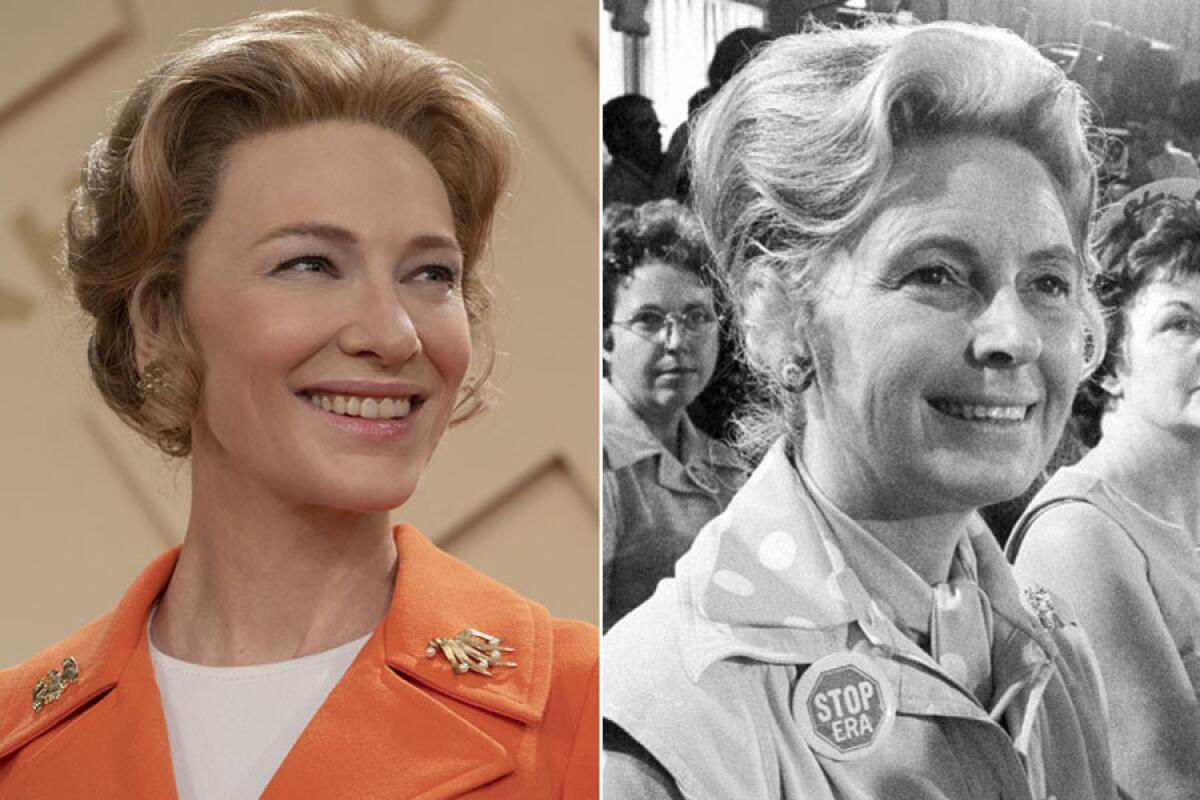How accurate is ‘Mrs. America’s’ portrayal of Phyllis Schlafly? We asked a historian

- Share via
If you’ve watched any of “Mrs. America,” the star-studded miniseries about the battle over the Equal Rights Amendment, you may be wondering how accurately it captures this divisive chapter in American political history.
The nine-part drama pits conservative activist Phyllis Schlafly (Cate Blanchett) and her followers against a band of feminist all-stars led by Gloria Steinem (Rose Byrne), Bella Abzug (Margo Martindale) and Betty Friedan (Tracey Ullman), who are prone to spirited internal debates. Creator Dahvi Waller and her team of writers conducted extensive research into Second Wave feminism and the rise of the new right in the 1970s.
Like nearly all works of historical fiction, “Mrs. America” takes some liberties, particularly when it comes to private conversations behind closed doors, and offers a necessarily subjective take on highly polarizing figures such as Schlafly, whose family has been critical of the series. But when it comes to events in the public record, “Mrs. America” hews very close to the facts, often quoting feminist leaders and their critics verbatim.
“Overall, they have done a very good job,” said historian Marjorie Spruill, author of “Divided We Stand: The Battle Over Women’s Rights and Family Values That Polarized America.”
In episode one, it’s 1971: The women’s movement, led by the newly formed National Women’s Political Caucus, is ascendant and the Equal Rights Amendment looks like it will sail to ratification. We meet Schlafly, a conservative activist and mother of six who turns from issues of national security to rally around opposition to the ERA.
Here’s a look at fact versus fiction in the first episode, “Phyllis”:
FX on Hulu limited series ‘Mrs. America’ brings the fight over the Equal Rights Amendment to life with Cate Blanchett as conservative activist Phyllis Schlafly.
Many of the anti-ERA characters are fictional creations
Because most of the women in the Stop ERA movement (later organized into the Eagle Forum) were homemakers and private citizens and Schlafly was by far its most recognizable member, Waller invented several composite characters on the “anti” side of the series, including Alice (Sarah Paulson) and Pamela (Kayli Carter). “I wanted to understand [Schlafly’s] appeal to homemakers who were the foot soldiers in her army, and in order to really understand, that you need to have characters who are actual homemakers,” Waller said. But Rosemary Thomson (Melanie Lynskey) and Ann Paterson (Teresa Pavlinek), who is introduced in episode two, were prominent real-life figures in the movement. Thomson even wrote a book about it.
At first, Phyllis Schlafly wasn’t that riled up about the ERA…
When we first meet Schlafly, she isn’t that concerned about the ERA. “I don’t know what all the fuss is about. There are so many more pressing issues,” she tells Alice. She also brushes off the matter during a meeting with Republican men, including Arizona Sen. Barry Goldwater (Peter MacNeill).
Schlafly initially saw the ERA as innocuous or even somewhat helpful, according to Spruill. As late as December 1971, she told fellow conservative women she wasn’t sure which side of the debate she was on, but eventually she became convinced by the literature they shared with her.
“She believed in this vision of American women as the most privileged creatures that there ever were and why would you throw that away?” Spruill said. In the February 1972 issue of The Schlafly Report newsletter, she came out against the amendment in an essay called “What’s Wrong With ‘Equal Rights’ for Women?”
“It is really amazing considering that she had such an impact on blocking the Equal Rights Amendment from becoming a part of our Constitution that when people first mentioned it to her, she wasn’t even very interested,” Spruill said.
… And neither were most Republicans
“Mrs. America” opens in 1971, a time when the ERA enjoyed support from politicians on both sides of the aisle. Both the House and the Senate adopted the measure by overwhelming margins before sending it to the states for ratification. It was not always seen as a liberal cause.
In fact, the ERA was around for decades before it was passed by Congress, and the limited support it enjoyed for most of that time was from Republicans, according to Spruill. President Dwight D. Eisenhower even called on Congress to adopt it. “They saw themselves as the party of Lincoln and individual liberties,” she explained. They also believed the ERA would mean equal laws for everyone and thus might help kill government regulation enacted during the Progressive Era, which is why labor groups for a time opposed it.
Eventually, protective legislation for both sexes had become law, and labor groups got on board. By the early ’70s, the ERA “had very strong bipartisan support,” Spruill said, marking a short-lived “golden age for the women’s rights movement” in the United States.
FX on Hulu series “Mrs. America,” about the fight for — and against — the Equal Rights Amendment — is compelling, ambitious TV drama.
Schlafly was perceived as a marginal figure who’d lost her influence in the Republican Party
As Friedan, Abzug and the members of the National Women’s Political Caucus celebrate the passage of the ERA in the Senate, Jill Ruckelshaus — a Republican feminist played by Elizabeth Banks— dismisses Schlafly, who’s just come out against the ERA in her newsletter, as a “right-wing nut from Illinois.” Abzug also brushes her off as someone “on the fringe.”
This view was widely held on both sides of the aisle, Spruill said. Schlafly had first gained national attention with her 1964 book, “A Choice Not an Echo,” in which she attacked the Republican party’s East Coast establishment and made the case for Goldwater. The book helped Goldwater secure the nomination in 1964, despite opposition from many party leaders. “After Goldwater was defeated in a landslide [by Lyndon Johnson], the moderates and liberals within the party were furious with her,” Spruill said. “Her wing of the party was not riding high” in the early ’70s.
There was uncertainty about what the ERA would achieve, but some homemakers genuinely feared it
Several characters, including Alice, express concern over the ramifications of the ERA, worrying that their daughters would get drafted or their husbands could sue them for alimony. When Schlafly brushes off her fears about the ERA, Alice fires back, “You have nothing to worry about. You have skills. You’ve been politicking for years. You’re not just a housewife.”
These conversations accurately reflect the fears many women had about the ERA. Whether their fears were justified is another matter, Spruill explained. “The very vagueness of the Equal Rights Amendment meant there was going to be a lot of argument about what it would do, and that would have to be worked out in the courts and in the legislature. It wasn’t super clear.”
Many of Schlafly’s foot soldiers were women who, like Alice, “didn’t believe that they had marketable skills [outside the home]. The idea that they would be forced out into the job market to compete with men was genuinely frightening for them. But of course the Equal Rights Amendment was not going to force them out into the job market.”
Fred Schlafly supported his wife’s political goals
“Phyllis” suggests that Schlafly took up the cause of defeating the ERA because her ambition of holding elected office had been thwarted. Her husband, Fred (John Slattery), discourages her from a third run for Congress because he is concerned about her being away from home. “They’re making him [out] to be less supportive of her political goals than I believe he was. I think generally speaking they were two peas in a pod,” Spruill said.
(For what it’s worth, Schlafly’s daughter, Anne Schlafly Cori, also has pushed back against the series’ portrayal of her parents’ marriage, particularly a scene that she says portrays him as a rapist. “My father loved the success that Phyllis achieved and Fred Schlafly liked to quip, ‘I regret that I have but one wife to give to my country,’” she said in an email.)
More to Read
The complete guide to home viewing
Get Screen Gab for everything about the TV shows and streaming movies everyone’s talking about.
You may occasionally receive promotional content from the Los Angeles Times.






